Fabry disease
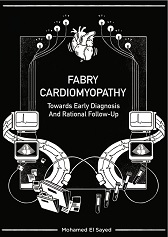
Fabry disease (FD) is a rare, inherited, slowly progressive X-linked lysosomal storage disorder. Mutations in the galactosidase alpha gene (GLA) are the primary cause of FD, leading to a decreased activity of the lysosomal enzyme alpha-galactosidase A (AGAL). This results in intracellular accumulation of the enzymes’ main substrate, globotriaosylceramide (Gb3) in various organs, including the heart, which ultimately lead to organ damage.
During adulthood, symptomatic cardiac disease in the form of conduction abnormalities, arrhythmias, ischemic heart disease and heart failure may arise, ultimately leading to cardiac death in many patients. Alterations in electrophysiological markers and cardiac morphology and function precede the development of clinical heart disease. Currently, knowledge on the course of these changes and in which patients they arise is lacking. Specifically, the age of occurrence, the progression rate and how these markers of cardiac disease are linked to clinical outcomes is limited.
The main goal of the thesis is to study the cardiac manifestations of FD, the course of electrophysiological and echocardiographic features in men and women with FD throughout adult life, and how they differ from the healthy population. With this knowledge, it will be possible to identify and treat FD patients at risk for developing cardiac events and to develop tailored follow-up protocols taking these prognostic markers into account.
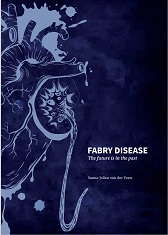
Fabry disease is a rare lysosomal storage disease, caused by pathogenic mutations in the alpha-galactosidase-A gene resulting in a dysfunctional enzyme. Over two decades ago, enzyme replacement therapy (ERT) became available for patients, with approval based on mostly surrogate (pre-clinical) endpoints. Over the years it became evident that treatment may slow down disease progression when initiated early in the disease process, but cannot fully halt disease progression. Therefore, research into new treatment methods has recently increased, with a multitude of new drugs currently in (clinical) research. Meanwhile, the availability of a treatment for Fabry disease has led to an increase in (genetic) diagnostics and the discovery of many GLA variants associated with a milder- or uncertain disease course. The clinical distinction between 'classical' disease (more severe) and 'non-classical' disease (milder) has helped to improve prognostic information and clinical decision making. However, Fabry disease appears to be more of a spectrum then a dichotomous disease, ranging from the GLA variant impacting cardiovascular risk only, to severe monogenetic multi-organ disease. Finally, the negative impact of the development of neutralizing antibodies against ERT has long been underestimated.
The aim of this thesis is therefore threefold, I. to improve prognostic information in newly diagnosed patients regarding their expected disease course. II. Examining the clinical effects of antibodies against ERT and analyzing which patients are most at risk for developing them. III. Finding leads to make the treatment of FD more effective, by optimizing the timing of treatment initiation and by preventing antibody formation.

Cerebral involvement is common in Fabry disease (FD). This thesis aimed to incorporate patients’ illness perception (e.g. depressive symptoms, quality of life) into the physicians’ practice (follow-up schedules and treatment). We aimed to improve prognostication, prevent cerebral involvement and stimulate appropriate use of enzyme replacement therapy (ERT).
In the Dutch FD cohort, cognitive impairment, subjective cognitive complaints and depressive symptoms were all found, with a high prevalence of the latter two. Assessment of depressive symptoms using a questionnaire should be included in routine follow-up of FD patients. Progression of white matter lesions (WMLs) and infarctions was related to the patients’ age, sex and phenotype. Unexpectedly, we found no association between progression of WMLs or infarctions and ERT or cerebrovascular risk factors. This provided a sobering view of the manageability of WMLs and infarctions in FD. Patients should be informed that WMLs will increase with age, despite treatment with ERT.
FD patients with a history of stroke experienced a decreased quality of life and had a higher risk of cognitive impairment, emphasizing the importance of preventing stroke. WMLs were not related to cognitive functioning or depressive symptoms, showing there is a need for clinically relevant and validated cerebral biomarkers.
In conclusion, we believe that this thesis may improve communication between doctors and patient, guides the appropriate use of ERT and gives clear directions for future research. We also make a plea for longitudinal studies for FD, with smart designs and robust methodology to improve comparability and interpretability of results.
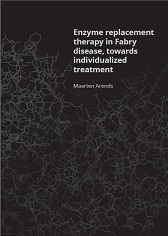
Fabry disease is a very heterogeneous disorder for which expensive enzyme replacement therapy is available since more than 15 years. Because of the variety of symptoms and disease course, individual choices need to be made to improve the appropriate use of therapy. Supported by ZONWM, we have been able to create a unique, independent, database, of almost 600 Fabry disease patients from three European Fabry disease centers of excellence.
The aim of this thesis was to describe the differences in the disease course between treated and untreated male and female patients with a classical or a non-classical phenotype and the effects of two different enzymes. We established that phenotype (classical or non-classical) and gender were major determinants for the disease severity in untreated patients. This crucial information could then be used to study effects of enzyme replacement therapy, showing that, after adjustment for gender, phenotype and age, we could identify risk factors for disease progression, including renal function at baseline, a history of one or more events and left ventricular mass. Importantly, we have also been able to show differences in effect of enzyme replacement therapies, with less immunogenicity of agalsidase alfa, but better biochemical and, albeit limited, clinical improvement for the higher dosed agalsidase beta.
In conclusion, the results of this thesis will fuel the discussion on start and stop criteria for enzyme replacement therapy and highlight the importance of phenotype, gender and age in the evaluation of the disease course.
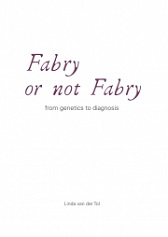
Fabry disease is a lysosomal storage disorder with an X-linked pattern of inheritance. Fabry disease is caused by impaired degradation and accumulation of the glycosphingolipid globotriaosylceramide, due to a deficiency of the enzyme α-Galactosidase A. Both males and females can be affected, although in general, females demonstrate a more attenuated phenotype. Screening and individual diagnostic testing revealed a higher prevalence than expected of individuals with variants in the Fabry gene. However, while these individuals may have Fabry disease, a variant in the Fabry gene may also be non-pathogenic. This caries the risk of misdiagnosis, inappropriate counseling, and unjustified treatment with expensive enzyme replacement therapy.
The aim of this thesis was to improve the diagnosis of Fabry disease, in order to support the diagnostic process in individuals with a genetic variant of unknown significance in the Fabry gene. A literature review on screening for Fabry disease showed that a large number of individuals with a non-specific clinical feature such as cardiac hypertrophy, chronic kidney disease of stroke, do not demonstrate characteristic signs or symptoms as seen in classical Fabry disease. In collaboration with (inter)national experts on Fabry disease we developed diagnostic guidelines to aid in the diagnostic approach for these individuals, using the best available evidence from the literature and additional analyses. Furthermore, we specifically studied the diagnostic value of clinical and biochemical features characteristic of classical Fabry disease.
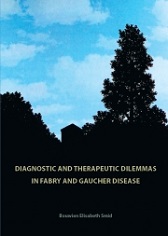
Fabry disease and Gaucher disease are lysosomal storage disorders with a variable phenotype. Mutations in the gene for Fabry disease can lead to a classical, severe phenotype, a non-classical, milder phenotype or lead to no Fabry disease at all. An increasing number of screening studies are performed in order to identify patients who may potentially benefit from enzyme replacement therapy. These studies reveal mutations or genetic variants of unknown significance for which pathogenicity is not clearly established. These individuals are faced with an uncertain diagnosis of Fabry disease. Individuals identified through screening studies may receive an unjustified diagnosis of Fabry disease which may lead to unjustified initiation of burdensome and very costly treatment with enzyme replacement therapy.
The aim of this thesis was to investigate the variable phenotype of Fabry disease and the resulting diagnostic dilemmas. In collaboration with international Fabry experts diagnostic guidelines are proposed to improve the diagnostic process in patients with an uncertain diagnosis of Fabry disease.
A second aim was to investigate the long-term effects of enzyme replacements therapy for Fabry disease. It is concluded that better treatment options are needed for Fabry disease, given that complications occur despite enzyme replacement therapy. Finally, novel therapeutic approaches for lysosomal storage disorders are evaluated. The thesis focusses particularly on eliglustat, a new promising oral substrate inhibitor for the treatment of Gaucher disease.

Globotriaosylsphingosine is a recently discovered, sensitive biomarker for Fabry disease. This metabolite possibly plays a role in the vascular pathology of Fabry disease as described by the research of Saskia Rombach.
Fabry disease is a rare, inborn error of metabolism characterized by a deficiency of the enzyme alpha-Galactosidase A.
Saskia Rombach also evaluated the long-term effect of two enzyme replacement therapies. To study the cost-effectiveness a life time Markov model was developed. Her research shows that enzyme replacement therapy (ERT) – combined with supportive treatment – can slow disease progression, though disease progression is not halted. The effectiveness of ERT most likely varies between certain subgroups of patients. This result in very high costs of ERT per QALY (quality adjusted life year).
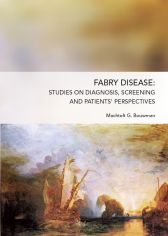
Fabry disease is a rare, severe inborn error of metabolism in which the metabolism of certain fatty molecules is impaired. This may lead to heart failure, kidney failure and brain damage in adults. Treatment with enzyme replacement therapy is not optimal.
Machtelt Bouwman investigated whether or not Fabry disease should be included in the national heel prick test (neonatal screening program for the detection of several disorders in newborns).
She currently deems this undesirable given the current lack of evidence that early treatment is effective. Furthermore, it is difficult to predict the disease course in patients that do not (yet) display clear symptoms.

There are currently over 50 storage disorders known, which greatly vary in severity. Some disorders are characterized by severe mental retardation, neurological problems an early death; other disorders do not influence life expectancy. The disorders in the latter category can include neurological problems, that may be cumbersome or disabling.
Marieke Biegstraaten investigated the severity and course of neurological complications in adult patient with Gaucher disease type I and Fabry disease. Gaucher disease type I patients often have neurological manifestations that interestingly do not always cause problems in their daily lives. Fabry disease patients often show impaired pain and cold sensation. The autonomic nervous system is spared.
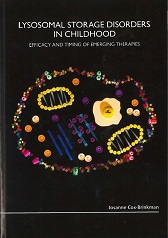
Josanne Cox-Brinkman investigated several treatment strategies for Gaucher disease, Fabry disease Mucopolysaccharidosis I and Niemann-Pick type A/B disease. These lysosomal storage disorders result from enzyme deficiencies resulting in accumulation of substrate. Treatments such as enzyme replacement therapy and substrate reduction therapy have been available for several years. In some cases initiation of treatment at an early age might be useful limiting progression of symptoms. Treatments are usually burdensome and require numerous hospital visits. Optimal timing of treatment is therefore important.

Subject of the thesis is the effectiveness of enzym replacement therapy (ERT) in Fabry disease (an inherited storage disorder) and the pathophysiological aspects of this disease.
The efficacy of the two available ERT’s does not appear to differ significantly. The largest effect is observed in patients who display relatively mild symptoms. In patients who present with advanced kidney disease before initiation of treatment, further deterioration of renal insufficiency during ERT is frequently observed.
Early initiation of treatment may therefore be important. Home treatment is feasible and safe. This is important because Fabry patients require lifelong treatment.
Gaucher disease

Martine Regenboog investigated the role of iron in the pathophysiology and imaging of Gaucher disease. She particularly investigated a link between iron-related pathophysiological changes and the occurence of associated conditions in this rare lysosomal disorder.
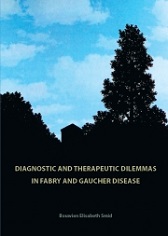
Fabry disease and Gaucher disease are lysosomal storage disorders with a variable phenotype. Mutations in the gene for Fabry disease can lead to a classical, severe phenotype, a non-classical, milder phenotype or lead to no Fabry disease at all. An increasing number of screening studies are performed in order to identify patients who may potentially benefit from enzyme replacement therapy. These studies reveal mutations or genetic variants of unknown significance for which pathogenicity is not clearly established. These individuals are faced with an uncertain diagnosis of Fabry disease. Individuals identified through screening studies may receive an unjustified diagnosis of Fabry disease which may lead to unjustified initiation of burdensome and very costly treatment with enzyme replacement therapy.
The aim of this thesis was to investigate the variable phenotype of Fabry disease and the resulting diagnostic dilemmas. In collaboration with international Fabry experts diagnostic guidelines are proposed to improve the diagnostic process in patients with an uncertain diagnosis of Fabry disease.
A second aim was to investigate the long-term effects of enzyme replacements therapy for Fabry disease. It is concluded that better treatment options are needed for Fabry disease, given that complications occur despite enzyme replacement therapy. Finally, novel therapeutic approaches for lysosomal storage disorders are evaluated. The thesis focusses particularly on eliglustat, a new promising oral substrate inhibitor for the treatment of Gaucher disease.

Gaucher disease is an autosomal recessively inherited lysosomal storage disorder (LSD). Type I Gaucher disease, the so-called non-neuronopathic variant, is mainly characterised by cytopenia, hepatosplenomegaly and bone complications. Gaucher disease was the first LSD for which enzyme replacement therapy (ERT) became available in the early 90s. Studies have shown ERT to be highly effective in reversing cytopenia, reducing organomegaly and decreasing bone marrow infiltration. In this thesis the pathophysiology of long-term complications of Gaucher disease ,and the effect of ERT on these, is studied with special attention for the cost-effectiveness of ERT. Furthermore, a number of important markers to study disease severity is evaluated.
The thesis shows that ERT can reduce the incidence of long-term complications, i.e. the need for splenectomy and the incidence of bone complications. Nonetheless, costs of treatment per quality adjusted life-year (QALY) are high.
Bone complications have an important impact on the quality of life of patients and are hypothesized to result from an imbalance in bone remodelling, characterized by a decrease in bone formation. Finally, it is increasingly recognized that malignancies represent one of the long-term complications of Gaucher disease. This is particularly true for the haematological malignancies, but includes the hepatocellular carcinoma as well.

There are currently over 50 storage disorders known, which greatly vary in severity. Some disorders are characterized by severe mental retardation, neurological problems an early death; other disorders do not influence life expectancy. The disorders in the latter category can include neurological problems, that may be cumbersome or disabling.
Marieke Biegstraaten investigated the severity and course of neurological complications in adult patient with Gaucher disease type I and Fabry disease. Gaucher disease type I patients often have neurological manifestations that interestingly do not always cause problems in their daily lives. Fabry disease patients often show impaired pain and cold sensation. The autonomic nervous system is spared.

Gaucher disease type I is an inborn error of metabolism in which certain fatty molecules, glycosphingolipids, accumulate in different cells of the body.
Mirjam Langeveld showed that this leads to several metabolic abnormalities such as a reduced sensitivity to insulin and altered cholesterol homeostasis.
Treatment with enzyme replacement therapy leads to overweight in many patients and possibly an increased risk of type II diabetes. Reduced plasma HDL-cholesterol levels in Gaucher patients do not lead to an increased risk for atherosclerotic cardiovascular disease.
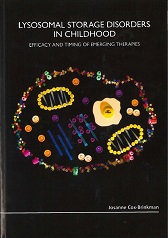
Josanne Cox-Brinkman investigated several treatment strategies for Gaucher disease, Fabry disease Mucopolysaccharidosis I and Niemann-Pick type A/B disease. These lysosomal storage disorders result from enzyme deficiencies resulting in accumulation of substrate. Treatments such as enzyme replacement therapy and substrate reduction therapy have been available for several years. In some cases initiation of treatment at an early age might be useful limiting progression of symptoms. Treatments are usually burdensome and require numerous hospital visits. Optimal timing of treatment is therefore important.
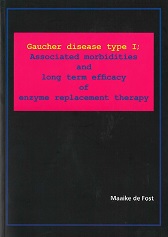
Patients with Gaucher disease type I, an inherited storage disorder, show a deficiency of a certain enzyme. As a result, storage of substrate occurs and this results in damage. Enzyme replacement therapy (ERT), though effective, is costly.
Research shows that some patients can succesfully be treated with a relatively low dose of ERT. Other patients, specifically those with bone complications, require a high dose of ERT.
As a result of effective treatment, focus has shifted from the main symptoms to morbidity and mortality caused by associated diseases. The risk of multiple myeloma (a type of cancer, also called morbus Kahler) is significantly increased in Gaucher patients, the risk of cardiovascular disease is not.
MPS I
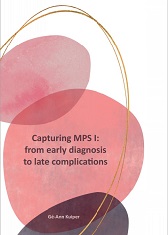
Mucopolysaccharidosis I (MPS I) is a rare storage disorder that results from a deficiency of a specific enzyme (IDUA). As a result, certain substrates are not degraded. These substrates accumulate which result in dysfunctional cells. This initiates pathological processes that cause progressive damage and progressive disease. Within MPS I, three subtypes are distinguished based on the severity of the symptoms and the age at which they occur. In her thesis, Kuiper examines the challenges of (early) diagnosis, the effectiveness of the treatment and the residual symptoms despite treatment.

Mucopolysaccharidosis type I (MPS I) is a lysosomal storage disease, in which the accumulation of undegraded glycosaminoglycans leads to a progressive multisystem disease. Despite available treatments, a significant residual disease burden is seen in patients.
This thesis contains three parts, focusing on different aspects of residual disease. In the first part, methods for an early and accurate diagnosis and classification are sought. This will provide an opportunity for start of treatment in an early phase of the disease, which will provide a better chance of prevention of clinical manifestations.
In the second part the effect of the currently available enzyme replacement therapy and subsequent antibody formation on biochemical correction is described. These parameters are furthermore correlated with the presence and severity of sleep apnea. A modified enzyme replacement therapy is evaluated for improvement of accumulation of glycosaminoglycans in the central nervous system.
In the final part, the focus lies on skeletal manifestations of the disease. Both the radiological trends and optimal treatment strategies for a characteristic form of hip dysplasia are described, contributing to optimizing clinical care for patients with MPS I.
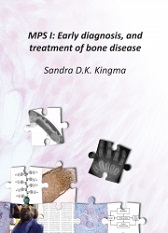
Mucopolysaccharidosis type I (MPS I) is a lysosomal storage disease (LSD) characterized by deficient degradation and subsequent accumulation of glycosaminoglycans (GAGs). Patients present with a spectrum of symptoms, including progressive mental retardation and bone disease. To optimize outcome, early recognition of the clinical phenotype to guide decisions on therapeutic strategies are needed. Also, treatment of MPS I bone disease is currently not effective and lack of knowledge on pathophysiological mechanisms limits the development of new therapeutics.
This thesis comprises studies on early diagnosis of MPS I, and pathophysiology and treatment of MPS I bone disease. Chapter 2 provides an overview of the epidemiology, diagnostics and challenges of screening for LSDs. In Chapter 3, we describe an algorithm to predict the MPS I phenotype at a young age, which can be used to guide decisions on the proper treatment before the onset of symptoms and irreversible organ damage. In Chapter 4, a study on the secondary pathological effects of GAG accumulation is described. Chapter 5 describes alterations in growth factors and GAGs in MPS I bones, which is likely involved in the development of MPS I bone disease. Finally, in Chapter 6 and 7, adverse effects of genistein are described in MPS I cells and mice. Because genistein has been promoted as a treatment for MPS III and is available over the counter, this information discourages the use of genistein in MPS I patients outside a clinical trial. Chapter 8 comprises a general discussion and future perspectives.
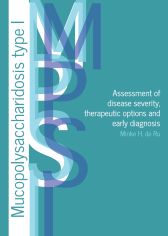
Certain molecules in blood and urine, so called biomarkers, can be used to diagnose the inborn error of metabolism Mucopolysaccharidosis type I (MPS I) in blood samples drawn as part of the heel prick screening (newborn screening). This is shown by research performed by Minke de Ru.
Her research focused on establishing consensus among physicians regarding the indication and optimal timing of the two available treatment options for MPS I, the classification of the different MPS I phenotypes and early diagnosis of the disease. Implementation of newborn screening for MPS I has several advantages, but there are also relevant ethical issues that need to be considered.
Minke de Ru also showed that biomarkers may be useful in determining the effect of treatment and differentiating between the different MPS I phenotypes.
MPS I is a rare inborn error of metabolism in which the catabolism of certain glycosaminoglycans is defective. The subsequent continuous accumulation leads to progressive multi-system disease. Its clinical spectrum ranges from the severe Hurler phenotype to the more attenuated Scheie phenotype. Early diagnosis and start of treatment appears to be essential to optimize treatment outcomes.
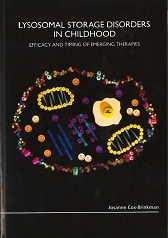
Josanne Cox-Brinkman investigated several treatment strategies for Gaucher disease, Fabry disease Mucopolysaccharidosis I and Niemann-Pick type A/B disease. These lysosomal storage disorders result from enzyme deficiencies resulting in accumulation of substrate. Treatments such as enzyme replacement therapy and substrate reduction therapy have been available for several years. In some cases initiation of treatment at an early age might be useful limiting progression of symptoms. Treatments are usually burdensome and require numerous hospital visits. Optimal timing of treatment is therefore important.
MPS III

Mucopolysaccharidosis type III, also known as MPS III or Sanfilippo syndrome, is a lysosomal storage disorder with an autosomal recessive (AR) inheritance pattern. MPS III is part of the mucopolysaccharidoses (MPSs), a group of seven different genetic disorders, all accumulating different types of glycosaminoglycans (GAGs). MPS III is caused by an enzyme deficiency of one of the four lysosomal enzymes involved in the degradation of the GAG heparan sulfate (HS). The four enzymes correspond with the four different subtypes: MPS IIIA (heparan N-sulfatase; SGSH), MPS IIIB (N-α-acetylglucosaminidase; NAGLU), MPS IIIC (acetyl CoA:α-glucosaminide N-acetyltransferase; HGSNAT), and MPS IIID (N-acetylglucosamine 6-sulfatase; GNS). Clinically, these subtypes are indistinguishable.
This thesis comprises a number of studies aiming to improve knowledge about the MPS III disease course and the phenotypic spectrum, to provide insights in the attitudes towards preconception expanded carrier screening and the psychosocial well-being of parents of MPS III patients, and finally, to provide an overview of possible future therapies, highlighting the challenges.

Mucopolysaccharidosis type III (MPS III) is a rare, but sever metabolic disorder which is divided into several subtypes. In its most progressive form, patients die in their early teens or adolescents. The disease results from a deficiency of an enzyme responsible for the degradation of heparansulfate. As a result, heparansulfate accumulates, which leads to progressive damage of cells. In order to work toward an effective therapy for MPS III, Olga Meijer investigated disease mechanisms, possible effective substrates and diagnostic procedures in this disorder.
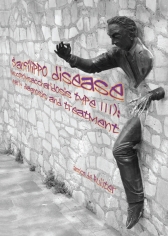
Mucopolysaccharidoses (MPS) are severe, inherited metabolic disorders caused by defective lysosomal degradation glycosaminoglycans (GAGs). The subsequent progressive accumulation of GAGs in cells and tissues in MPS patients results in extensive, severe and progressive disease, generally limiting quality of life and life expectancy. Sanfilippo disease (mucopolysaccharidosis type III, MPS III) is one of the 7 MPSs and is characterized by storage of the GAG heparan sulfate (HS), primarily leading to severe neurological symptoms, caused by rapid deterioration of brain functions. This thesis comprises several studies, all initiated with the purpose to obtain more insight in the pathophysiology of the disease and to improve treatment and care of Sanfilippo patients.
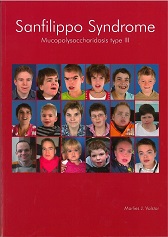
Sanfilippo syndrome (also known as MPS III) is a rare inborn error of metabolism. MPS III is caused by a defect in the degradation of heparan sulfate. This result in progressive mental retardation with childhood onset, resulting in dementia. Most patients die at a young age. A number of promising treatments are currently being investigated. Gaining extra knowledge on the natural course of MPS III and it’s four subtypes is necessary to determine the effects of treatment.
Marlies Valstar investigated over 200 patients with MPS III; all patients ever to have been diagnosed with MPS III in the Netherlands. She studied the clinical course, mental development and enotype of these patients. She discovered a remarkable broad spectrum of disease severity, which partially correlated with the genotype. These results are vital with regard to future studies on treatment.
Niemann-Pick type A/B
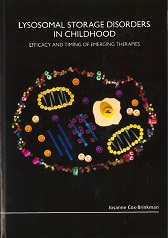
Josanne Cox-Brinkman investigated several treatment strategies for Gaucher disease, Fabry disease Mucopolysaccharidosis I and Niemann-Pick type A/B disease. These lysosomal storage disorders result from enzyme deficiencies resulting in accumulation of substrate. Treatments such as enzyme replacement therapy and substrate reduction therapy have been available for several years. In some cases initiation of treatment at an early age might be useful limiting progression of symptoms. Treatments are usually burdensome and require numerous hospital visits. Optimal timing of treatment is therefore important.
General/overall

In the European Union, a disease is called ‘orphan’ if it is a disorder that affects fewer than 5 per 10.000 of the population. Authorization of orphan drugs is often based on studies with several methodological shortcomings. Because of this, longer term effectiveness on clinically relevant outcome measures is often unclear at the time of authorization and some drugs that enter the market, may not be effective in the real-world.
The aim of this thesis was to study the presence of a so-called efficacy-effectiveness gap of orphan drugs, and the factors that possibly contribute to it. We confirmed that indeed a gap exists in the case of orphan drugs for metabolic diseases and oncology. The most important factor that contributed to this gap was the type of primary endpoint used in the pivotal study. This information may be used when conducting future studies on orphan diseases.
Furthermore, we showed that dose-finding studies in the case of metabolic and oncologic orphan drugs are not always conducted in the development program, while post-marketing evidence suggests that registered doses are not always considered as optimal.
Also, we elaborated on how an adaptive pathway approach could have benefitted the development of enzyme replacement therapy for Fabry disease in several ways, including 1) iterative development, 2) an independent disease registry with independent data analysis and 3) prescription control.
In conclusion, this thesis will contribute to an important discussion on the real-world effectiveness of orphan drugs.
